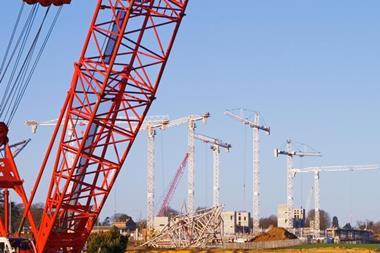The construction industry has been in carnage for some time. But it will always need insurance – a fact that is keeping the brokers that cover it on fairly stable ground
The UK construction industry is not a happy place to be right now. Insolvencies in the sector jumped by 20% in the first quarter of 2011 compared to the previous quarter, with some 586 construction firms going to the wall. Projects have been drying up too, with the sector’s output falling by 4% in the first quarter of the year, according to the Office for National Statistics.
Yet there are glimmers of hope for construction, with mothballed mega-projects like the so-called Cheesegrater, a skyscraper at 122 Leadenhall Street in the City, being back on site. So how are market conditions for those insuring this beleaguered sector?
Well-insulated
Compared to the carnage taking place within the construction industry, brokers that arrange insurance for large contractors like Balfour Beatty and Laing O’Rourke and for small local building firms, as well as for the building projects themselves, are relatively insulated.
These firms, which range from small brokers to a handful of the big players like Willis, Jardine Lloyd Thompson, Heath Lambert (which Gallagher bought earlier this month for £97m) and Lockton, say they are bearing up thanks to diversified books of business but also the fact that construction insurance is a must-buy.
Lockton partner David Hayhow says that although client volumes have a taken a hit, “the industry’s ability to buy insurance has not been affected, as you need insurance – including public liability and professional indemnity – to be able to trade. You will not be allowed on site without it.”
Insurers fight it out
There is a huge range of major insurers to choose from. Hayhow says there are “slightly fewer” than before the downturn but there are still 35 to 40 in London seeking construction business, and the big construction insurers include Aon, Munich, ACE, Aspen and Aviva.
There are specialists too, like HDI-Gerling, Mitsui Sumitomo and Thames Underwriting.
As a result, competition among the insurers remains fierce. Hayhow says: “Rates have really come down during the global downturn. For example, single project polices are down between 10% and 30% over the last three years.”
While this makes getting a good deal for your client easier, the flipside is that the market has been “very soft since 2008”, Hayhow says, which of course must affect brokers adversely in the long term.
So many claims, but who will pay?
So stiff is the competition between insurers that premiums have not been affected significantly by increased claims so far. Executive director at loss adjuster Cunningham Lindsey, Rupert Travis, says the downturn means contractors are on the hunt for any reason to make a claim. “It tends to start with the contractor claiming against the employer – in other words, the building’s developer – because some unforeseen circumstances, say, difficult ground conditions, have meant that the contractor has not made a profit on the job, and this eventually filters through to PI policies.”
He adds: “Often contractors’ claims are entirely legitimate but before the downturn they claimed less frequently because they were making plenty of money and were very busy. Now, they have surveyors with time on their hands who can be put to work making claims.”
Some experts argue that increased claims must translate into premium rises soon. Nick Patterson, commercial director at claims investigator Garwyn, says: “In the pre-downturn period, combined operating ratios were good, but now insurers are struggling so I believe we have to see a hardening of rates.”
But he concedes: “Not everyone may agree and there is still a fair bit of uncertainty around this.”
Big job, big risk
Despite the volume of insurers still keen on construction business in general, Bluefin head of marketing Peter Elliot says insuring large projects has become trickier. “It has become more difficult to secure insurance for projects in the downturn because there are fewer projects to spread risk over and lots of projects have been mothballed, which has put insurers off.”
It is less a question of price, he adds, than finding the capacity to insure projects that are typically extremely large and complex. “Essentially you are protecting massive, highly risky investments”.
It has also become more difficult for brokers to secure performance bonds for contractors. The providers of these bonds, which protect the property developer against the contractor going bust, such as Aviva, QBE and Zurich, “are becoming more conservative”, says Hayhow.
The reason for this is that contractors look less secure: “Over the last three years, contractors are seeing less cash on the balance sheet and less work coming in.”
On the plus side, adds Hayhow, these difficulties mean that while contractors often dealt directly with surety providers, they are now turning increasingly to brokers for help. While this has not led to an increase in business, he says, “it means we are about the same as where we were before the downturn with this type of business.”
No cranes going back up yet
Brokers do not expect conditions in the construction insurance market to change rapidly. There are signs of recovery in the private sector, with big name developers Land Securities and British Land returning to some projects, such as the latter’s Cheesegrater. But public sector building projects are only just beginning to slow down due to government spending cuts – one example being the culling of the £45bn Building Schools for the Future programme.
Elliot says: “There are signs of recovery – we are seeing cranes going back up particularly in the South East - but the return to normality is happening very slowly.”
However, he says that since the dependence of brokers and insurers directly on conditions in the construction sector is relatively slight, “we have weathered the storm and look forward to continuing to build on previous success.”
Hosted by comedian and actor Tom Allen, 34 Gold, 23 Silver and 22 Bronze awards were handed out across an amazing 34 categories recognising brilliance and innovation right across the breadth of UK general insurance.














































No comments yet